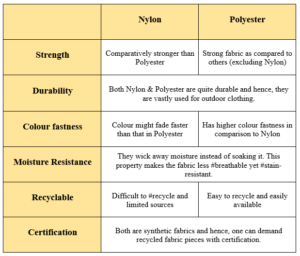In the realm of fabrics, there exists one that reigns supreme in terms of elegance,…

How is your Nylon different than Polyester?
After cotton, nylon and polyester are the next two most commonly known fabrics in everyday apparel. They both are spoken together whilst having quite extreme characteristics and purposes. When placed side by side, it is difficult to spot the difference. Their outer appearance is quite similar to the eye, but a touch of the hand will reveal great differences. Hence, they aren’t interchangeable, and here’s what sets them apart.
Polyester
Derived from petroleum, this synthetic fiber is one of the most popular textiles in the industry. It is famous for both consumer and industrial applications owing to its characteristics like resistance to shrinkage, easy to dry-clean/wash, non-stretching, etc. Different forms of polyester fabric include filament, fiberfill, tow, and staple. Globally speaking, China is the leading producer of polyester followed by India, Japan, the US, and Indonesia.
Filament polyester yarns are famously used in sportswear for their high endurance. With its capacity to withstand repetitive movements and water-repelling properties, polyester is also a famous raw material for manufacturing jackets and other garments suited for damp environments. However, it is also used to produce bags, footwear, trousers, shirts, etc. Polyester is a widely used fabric and one can see it in most everyday items.
At Anil International, we believe in providing the highest quality of filament polyester. Our associations with top-rated manufacturers will provide you with the most competitive prices for unquestionable quality.
Towards sustainability
Recycled Polyester is growing in popularity with its wide use and movements to sustain the environment. It is done so by recycling plastic bottles and converting them into PET chips. This prevents plastic bottles from going into landfills and instead puts them to good use.
However, at certain times when the garments are a blend of polyester and cotton, it becomes difficult to recycle them. Therefore, a huge number of garments are quite hard to process. Various institutions are working on a scalable solution to resolve this hurdle.
Nylon
One can say that nylon belongs to the polyester family of synthetic fabrics as it is derived from petroleum as well. However, it has some alterations to it. Nylon inclines more towards silk-based material. This material is heat resistant, durable, and light-weighted. It is highly used for toothbrush bristles, tents, fishing nets, etc. Its strength and durability also make it useful in the manufacturing of ropes that are used for mountain climbing.
Nylon is strong against dirt and isn’t weakened by sweat or chemicals that easily. This makes it an ideal choice for sportswear and activewear. However, extremely high temperatures can melt nylon. Therefore, it is advised that one should turn the nylon garment over and then iron it on a low temperature.
Nylon is categorized into two parts – Nylon 6,6 and Nylon 6.
Nylon 6,6 is the more common one as compared to the other type. It has superior traits of abrasion resistance, high melting point, and even resists sunlight.
Nylon 6 is preferred when we want to achieve higher elasticity and want more moisture absorbance capacity.
It is quite clear from the characteristics that Nylon 6,6 is preferred for industrial use and Nylon 6 performs better in the apparel industry.
Towards sustainability
Comparatively, it is difficult to recycle nylon than polyester. Recycling of nylon is done with pre, and post-consumer waste. The pre-consumer waste is the scraps of products and post-consumer waste is the discarded materials containing nylon. Even though it is difficult, recycling nylon aids in decreasing dependency on fossils and even saves huge amounts of oil that would go into manufacturing of the virgin material.
For the ease of understanding, we have identified basic parameters for judging a fabric and compared these two fabrics based on those parameters.

Follow us on LinkedIn for regular updates.



